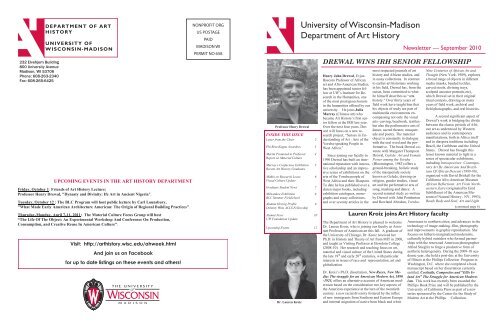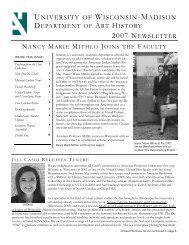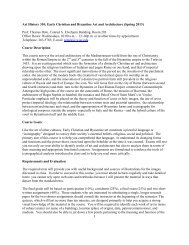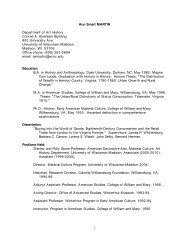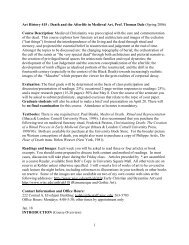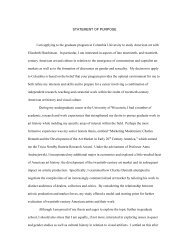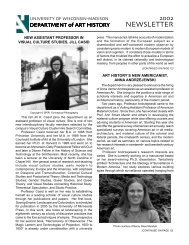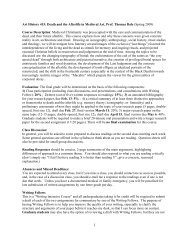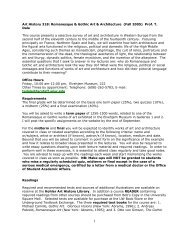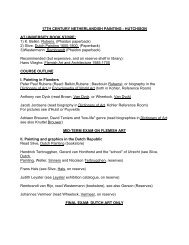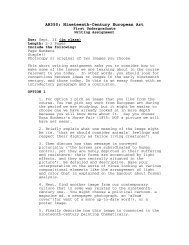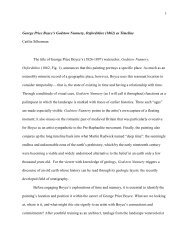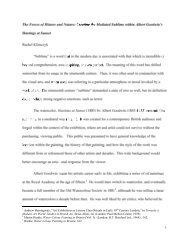University of Wisconsin-Madison Department of Art History
University of Wisconsin-Madison Department of Art History
University of Wisconsin-Madison Department of Art History
Create successful ePaper yourself
Turn your PDF publications into a flip-book with our unique Google optimized e-Paper software.
232 Elvehjem Building<br />
800 <strong>University</strong> Avenue<br />
<strong>Madison</strong>, WI 53706<br />
Phone: 608-263-2340<br />
Fax: 608-265-6425<br />
DEPARTMENT OF ART<br />
HISTORY<br />
UNIVERSITY OF<br />
WISCONSIN-MADISON<br />
UPCOMING EVENTS IN THE ART HISTORY DEPARTMENT<br />
Friday, October 1: Friends <strong>of</strong> <strong>Art</strong> <strong>History</strong> Lecture:<br />
Pr<strong>of</strong>essor Henry Drewal, "Dynasty and Divinity: Ife <strong>Art</strong> in Ancient Nigeria".<br />
Tuesday, October 12 : The BLC Program will host public lecture by Carl Lounsbury,<br />
"What Made Early American Architecture American: The Origin <strong>of</strong> Regional Building Practices".<br />
Thursday-Monday, April 7-11, 2011: The Material Culture Focus Group will host<br />
“The Life Of The Object: An Experimental Workshop And Conference On Production,<br />
Consumption, and Creative Reuse In American Culture”.<br />
Visit: http://arthistory.wisc.edu/ahweek.html<br />
And join us on Facebook<br />
for up to date listings on these events and others!<br />
NONPROFIT ORG<br />
US POSTAGE<br />
PAID<br />
MADISON WI<br />
PERMIT NO 658<br />
Pr<strong>of</strong>essor Henry Drewal<br />
INSIDE THIS ISSUE<br />
Letter from the Chair 2<br />
Phi Beta Kappa Awardees 3<br />
Martin Promoted to Pr<strong>of</strong>essor<br />
Report on Material Culture<br />
Murray’s Confucious Exhibition<br />
Recent <strong>Art</strong> <strong>History</strong> Graduates<br />
Mithlo on Research Leave<br />
Visual Culture Update<br />
Graduate Student News 7<br />
Milwaukee Exhibition<br />
BLC Summer Fieldschool<br />
Alumna Herzog Pr<strong>of</strong>ile<br />
Doherty Wins ACLS Fellowship<br />
Alumni News<br />
UW Foundation Update<br />
4<br />
5<br />
6<br />
8<br />
9<br />
10<br />
Upcoming Events 12<br />
Dr. Lauren Kroiz<br />
<strong>University</strong> <strong>of</strong> <strong>Wisconsin</strong>-<strong>Madison</strong><br />
<strong>Department</strong> <strong>of</strong> <strong>Art</strong> <strong>History</strong><br />
Henry John Drewal, Evjue-<br />
Bascom Pr<strong>of</strong>essor <strong>of</strong> African<br />
art and Afro-American Studies,<br />
has been appointed senior fellow<br />
at UW’s Institute for Research<br />
in the Humanities, one<br />
<strong>of</strong> the most prestigious honors<br />
in the humanities <strong>of</strong>fered by our<br />
university. He joins Julia<br />
Murray (Chinese art) who<br />
became <strong>Art</strong> <strong>History</strong>’s first senior<br />
fellow at the IRH last year.<br />
Over the next four years, Drewal<br />
will focus on a new research<br />
project, “Senses in Understanding<br />
<strong>of</strong> <strong>Art</strong> : <strong>Art</strong>s <strong>of</strong> the<br />
Yoruba-speaking People in<br />
West Africa.”<br />
Since joining our faculty in<br />
1990 Drewal has built an international<br />
reputation with innovative<br />
scholarship and an impressive<br />
series <strong>of</strong> exhibitions on the<br />
arts <strong>of</strong> the Yoruba people <strong>of</strong><br />
West Africa and their Diaspora.<br />
To date he has published over a<br />
dozen major books, including<br />
exhibition catalogues, monographs<br />
and essay collections,<br />
and over seventy articles in the<br />
most respected journals <strong>of</strong> art<br />
history and African studies, and<br />
in essay collections. In contrast<br />
to earlier art historians working<br />
in his field, Drewal has, from the<br />
outset, been committed to what<br />
he himself describes as “arts<br />
history.” Over thirty years <strong>of</strong><br />
field work have taught him that<br />
his objects <strong>of</strong> study are part <strong>of</strong><br />
multimedia environments encompassing<br />
not only the visual<br />
arts–carving, beadwork, textiles–<br />
but also the performative arts <strong>of</strong><br />
dance, sacred theater, masquerade<br />
and poetry. The material<br />
object is constantly in dialogue<br />
with the oral word and the performative.<br />
The book Drewal cowrote<br />
with Margaret Thompson<br />
Drewal, Gelede: <strong>Art</strong> and Female<br />
Power among the Yoruba<br />
(Bloomington, 1983) <strong>of</strong>fers a<br />
ground-breaking, holistic study<br />
<strong>of</strong> the masquerade society<br />
known as Gelede, drawing on<br />
religion, gender studies, visual<br />
art and the performative arts <strong>of</strong><br />
song, masking and dance. A<br />
second seminal study co-written<br />
by Drewal with John Pemberton<br />
and Rowland Abiodun, Yoruba:<br />
Newsletter — September 2010<br />
DREWAL WINS IRH SENIOR FELLOWSHIP<br />
Lauren Kroiz joins <strong>Art</strong> <strong>History</strong> faculty<br />
The <strong>Department</strong> <strong>of</strong> <strong>Art</strong> <strong>History</strong> is pleased to welcome<br />
Dr. Lauren Kroiz, who is joining our faculty as Assistant<br />
Pr<strong>of</strong>essor <strong>of</strong> American art this fall. A graduate <strong>of</strong><br />
the <strong>University</strong> <strong>of</strong> Chicago, Dr. Kroiz received her<br />
Ph.D. in <strong>History</strong> and Theory <strong>of</strong> <strong>Art</strong> from MIT in 2008,<br />
and taught as Visiting Pr<strong>of</strong>essor at Bowdoin College<br />
(2008-10). Her research and teaching focus on art,<br />
material and visual culture <strong>of</strong> the United States during<br />
the late 19 th and early 20 th centuries, with particular<br />
interests in issues <strong>of</strong> race and representation, art and<br />
globalization.<br />
Dr. Kroiz’s Ph.D. dissertation, New Races, New Media:<br />
The struggle for an American Modern <strong>Art</strong>, 1890<br />
-1925, <strong>of</strong>fers an alternative account <strong>of</strong> American modernism<br />
based on the consideration two key aspects <strong>of</strong><br />
the American experience at the turn <strong>of</strong> the twentieth<br />
century: a new racial diversity fostered by the influx<br />
<strong>of</strong> new immigrants from Southern and Eastern Europe<br />
and internal migration <strong>of</strong> native born black and white<br />
Nine Centuries <strong>of</strong> African <strong>Art</strong> and<br />
Thought (New York, 1989), explores<br />
a broad range <strong>of</strong> objects in different<br />
media (masks, beaded textiles,<br />
carved stools, divining trays,<br />
sculpted ancestor portraits etc),<br />
which Drewal set in their original<br />
ritual contexts, drawing on many<br />
years <strong>of</strong> field work, archival and<br />
field photographs, and oral histories.<br />
A second significant aspect <strong>of</strong><br />
Drewal’s work is bridging the divide<br />
between the classic periods <strong>of</strong> African<br />
art as understood by Western<br />
audiences and its contemporary<br />
manifestations, both in Africa itself<br />
and in diaspora traditions including<br />
Brazil, the Caribbean and the United<br />
States. Drewal has brought this<br />
lesser known material to light in a<br />
series <strong>of</strong> spectacular exhibitions,<br />
including Introspectives: Contemporary<br />
<strong>Art</strong> By Americans And Brazilians<br />
Of African Descent (1988-89),<br />
organized with David Driskell for the<br />
California Afro-American Museum<br />
African Reflections: <strong>Art</strong> From Northeastern<br />
Zaire (originated by Enid<br />
Schildkraut <strong>of</strong> the American Museum<br />
<strong>of</strong> Natural <strong>History</strong> , NY, 1993);<br />
Beads Body and Soul: <strong>Art</strong> and Light<br />
(continued page 6)<br />
Americans to northern cities; and advances in the<br />
technology <strong>of</strong> image-making–film, photography<br />
and improvements in graphic reproduction. She<br />
focuses on hitherto marginalized modernists,<br />
culturally hybrid outsiders who formed partnerships<br />
with the renowned American photographer<br />
Alfred Stieglitz to forge a productive form <strong>of</strong><br />
aesthetic heterogeneity. During the 2009-10 academic<br />
year, she held a post-doc at the <strong>University</strong><br />
<strong>of</strong> Illinois at the Phillips Collection Program in<br />
Washington, D.C. where she completed a book<br />
manuscript based on her dissertation currently<br />
entitled, Cocktails, Composites and “Ellis Island<br />
<strong>Art</strong>” The Struggle for American Modernism.<br />
This work has recently been awarded the<br />
Phillips Book Prize and will be published by the<br />
<strong>University</strong> <strong>of</strong> California Press as part <strong>of</strong> a new<br />
series sponsored by the Center for the Study <strong>of</strong><br />
Modern <strong>Art</strong> at the Phillips Collection.
PAGE 2<br />
It is with great pride that I look back on the<br />
achievement <strong>of</strong> our students and faculty. In<br />
this newsletter we feature stories about eight<br />
undergraduate majors who were honored by<br />
the Phi Beta Kappa Society, a recent Ph.D.<br />
graduate, Meghan Doherty (Ph.D.’10) who<br />
won a prestigious ACLS Fellowship, a recent<br />
art history major, Aurelia Moser (B.A.<br />
’09)who had a wonderful experience researching<br />
and teaching abroad in France<br />
with the help <strong>of</strong> a Fulbright, and a collaborative<br />
exhibition in Milwaukee involving<br />
current graduate students BA Harrington<br />
and Amy Powell as well as alumna Martha<br />
Monroe and faculty member, Jill Casid.<br />
We also pr<strong>of</strong>ile a prominent alumna,<br />
Melanie Herzog, whose career has taken<br />
unexpected turns as she moved from completing<br />
an MFA as a ceramicist to establishing<br />
herself in art history as an authority in<br />
American Indian art, Afro-American and<br />
Women’s Studies. All <strong>of</strong> these stories<br />
speak to the wide range <strong>of</strong> opportunities our<br />
department affords its students, including<br />
the pursuit <strong>of</strong> original research and field<br />
work both within the United States and<br />
around the globe, and presenting new ideas<br />
to a broader public through scholarly exhibitions<br />
and museum internships. Our department’s<br />
key role in two major campus<br />
programs—Material Culture and Visual<br />
Culture Studies—and a third interuniversity<br />
program with UW-<br />
Milwaukee,Buildings-Landscapes-Cultures<br />
(BLC), is also fostering cutting-edge research<br />
and learning that is truly interdisciplinary.<br />
Among the many recent successes <strong>of</strong> our<br />
faculty, we celebrate the promotion <strong>of</strong> Ann<br />
Smart Martin to full pr<strong>of</strong>essor, and the<br />
appointment <strong>of</strong> Henry J. Drewal as Senior<br />
Fellow at the Institute for Research in the<br />
Humanities. He joins Julia Murray who<br />
began her four-year senior fellowship at the<br />
Institute last year. We feature a brief story<br />
about Murray’s award-winning exhibition<br />
on Confucius. Other pr<strong>of</strong>essorial honors<br />
include the award <strong>of</strong> a Vilas Associate fellowship<br />
to Nick Cahill for his work on<br />
ancient Lydian coinage at Sardis, and sabbatical<br />
leaves for three other faculty members.<br />
Suzy Buenger will be completing<br />
research for her book on the German expressionist<br />
painter, Max Beckman, entitled<br />
Beckmann, The European, 1925-45: The<br />
Uninterrupted Work <strong>of</strong> Seeing. Jill Casid<br />
will be on leave in Paris researching a The<br />
Volatile Image: Other Histories <strong>of</strong> Photography.<br />
Finally, Anna Andrzejewski will<br />
be on leave in the fall semester to research<br />
books on vernacular architecture within the<br />
rural landscape <strong>of</strong> southwestern <strong>Wisconsin</strong><br />
and on Marshall Erdmann. She also begins a<br />
one-year term on the City <strong>of</strong> <strong>Madison</strong> Plan<br />
Letter from the chair—Thomas E. A. Dale<br />
Commission.<br />
I would like to report briefly on the four department<br />
priorities I listed in last year’s newsletter:<br />
rethinking our undergraduate curriculum,<br />
enhancing our global cultural reach,<br />
expanding our development efforts, and fostering<br />
a greater sense <strong>of</strong> intellectual community<br />
among our faculty and students. We have<br />
begun the conversation about curricular<br />
change, especially concerning how we teach<br />
the grand surveys <strong>of</strong> Western art, and we are<br />
developing a new entry-level undergraduate<br />
course that considers art and visual culture<br />
globally according to major themes. We<br />
have secured the support <strong>of</strong> Middle Eastern<br />
Studies, Religious Studies and the Lubar<br />
Institute for the Study <strong>of</strong> Abrahamic Religions<br />
to request a new faculty line in Islamic<br />
art, and we hope that this initiative will bear<br />
fruit in the near future either through a Title<br />
VI program or<br />
private donations.<br />
We have temporarily<br />
been able to fill<br />
an important gap in<br />
our curriculum<br />
courtesy <strong>of</strong> Christiane<br />
Clados, honorary<br />
fellow in Anthropology,<br />
who<br />
taught an introductory<br />
survey <strong>of</strong> Pre-<br />
Columbian art last<br />
fall, and is again<br />
teaching a course for us this fall.<br />
In the area <strong>of</strong> development, I am pleased to<br />
report that Pr<strong>of</strong>. Nancy Rose Marshall, last<br />
year’s chair <strong>of</strong> the Development Committee<br />
and our Visual Resources Curator, Jacob<br />
Esselstrom (M.A. ’04), have begun to update<br />
our modes <strong>of</strong> communication with current<br />
students, alumni and friends, by introducing a<br />
FaceBook Page (accessible at<br />
www.arthistory.wisc.edu). She is also working<br />
with Jacob to revamp our department<br />
website. On the fundraising side, a fund in<br />
honor <strong>of</strong> Ray Reider Golden (B.A. ’69) has<br />
reached maturity, and interest income will be<br />
available to “meet the <strong>Department</strong>’s most<br />
pressing needs” with special consideration<br />
given to projects related to Ray’s areas <strong>of</strong><br />
particular interest: ceramics, Northern European<br />
and American art. A story in this issue<br />
also highlights the successful joint venture<br />
with the Chazen to fund a graduate internship<br />
in the museum last year: Matthew Rarey<br />
worked on the new installation <strong>of</strong> African and<br />
African Diaspora art. We would like to be<br />
able to continue this arrangement in the future,<br />
but we don’t have the funds available to<br />
contribute our share. I would encourage our<br />
alumni and friends—many <strong>of</strong> whom are museum<br />
pr<strong>of</strong>essionals and patrons--to support<br />
this essential opportunity for students to gain<br />
curatorial experience with an internship at the<br />
Chazen or other area museums. The cost <strong>of</strong> a<br />
standard project assistantship <strong>of</strong> this kind,<br />
including tuition costs amounts to about<br />
$25,000.00. Please get in touch with me<br />
(tedale@wisc.edu; 608-263-5783) or with<br />
Jon Sorenson (B.A. ’85)<br />
(Jon.sorenson@uwfoundation.wisc.edu ; 608<br />
-267-7211) if you would like to learn more<br />
about supporting our department.<br />
This past year our department worked on<br />
building a stronger intellectual community by<br />
inaugurating a thematic biennium focused on<br />
the theme Object, Body, Mind and the<br />
Senses. We explored the ways in which<br />
physical objects and works <strong>of</strong> art mediate<br />
between the physical world <strong>of</strong> the senses and<br />
the realm <strong>of</strong> the mind, the spiritual or the<br />
other-worldy. The public programming included<br />
lectures by Jacqueline<br />
Jung (Yale),<br />
John Onians (East Anglia)<br />
and Eric Palazzo<br />
(Poitiers), and a series <strong>of</strong><br />
linked symposia organized<br />
by members <strong>of</strong> our<br />
department in conjunction<br />
with Center for<br />
Visual Culture’s yearlong<br />
theme, “Visualities<br />
beyond Ocularcentrism”<br />
coordinated by Jill<br />
Casid. One <strong>of</strong> these<br />
symposia Material Images, The Senses and<br />
Religious Experience brought back to campus<br />
our distinguished alumna, Pamela Sheingorn<br />
(Ph.D. ’74; CUNY) to speak on “Seeing<br />
Hearing: The potential for Multisensory<br />
Reception in Early Illustrated Lives <strong>of</strong><br />
Mary.” Another important venue for stimulating<br />
conversation among our faculty, students,<br />
alumni and friends is the Friends <strong>of</strong><br />
<strong>Art</strong> <strong>History</strong> Lectures series. This past year<br />
we enjoyed stimulating talks by two faculty<br />
members, Nancy Rose Marshall on the Pre-<br />
Raphaelite painter Dante Gabriel Rossetti,<br />
and Narciso Menocal on Cuban Architecture.<br />
For the first time, our Friends were also<br />
given the chance to hear a lecture by one <strong>of</strong><br />
our talented graduate students: Ph.D. candidate<br />
Marsely Kehoe spoke on vernacular<br />
architecture and cultural hybridity in colonial<br />
Jakarta.<br />
Two other important occasions for the exchange<br />
<strong>of</strong> ideas are the <strong>Department</strong> colloquium<br />
series, organized this year by Gail<br />
Geiger, <strong>of</strong>fering faculty and students a venue<br />
to present new work, and the Honors colloquium<br />
in which we showcase the research<br />
completed for honors theses by some <strong>of</strong> our<br />
talented graduating seniors. This year, we<br />
heard stimulating (continued page 5)<br />
Alumni News, continued..<br />
Leah Purisch (BA ‘97, MA ‘00) currently works<br />
as a pr<strong>of</strong>essional portrait painter from her home in<br />
Lake Mills, <strong>Wisconsin</strong>.<br />
Jennifer Rice (BA ‘92) launched her own company<br />
in 2006, Rice Public Relations LLC, specializing<br />
in PR and marketing for Seattle area nonpr<strong>of</strong>it<br />
arts organizations. Clients include dramatic<br />
and musical theatre companies, art galleries, dance<br />
companies, touring productions and choral groups.<br />
Abraham Ritchie (BA ‘06) is an active art critic<br />
and writer. He is the Chicago Editor for the online<br />
arts website <strong>Art</strong>Slant and maintains the Chicago<br />
<strong>Art</strong> Blog on the ChicagoNow site, a subsidiary <strong>of</strong><br />
Tribune Media, Inc. He has also written art criticism<br />
for <strong>Madison</strong> Newspapers, Inc., NewCity, and<br />
Aurelia Moser (BA ‘09) reflects on how UW prepared her for Research, Teaching in France<br />
As an undergraduate in <strong>Art</strong> <strong>History</strong> at UW, I had the opportunity to conduct research, explore a range <strong>of</strong> study specializations, and pursue travel<br />
opportunities culminating in my current work in the south <strong>of</strong> France. I can’t help but be grateful for my initial introduction to art historical research.<br />
Through internships at the <strong>Art</strong> Institute <strong>of</strong> Chicago and the Helen Louise Allen Textile Collection, I developed a familiarity with art historical<br />
library resources, art handling, exhibition installation, and museum collections cataloguing, supplemented by classroom study in <strong>Art</strong> <strong>History</strong>,<br />
Museum<br />
Studies, and European Languages. Working primarily with the conservation <strong>of</strong> works on paper and the<br />
conversion <strong>of</strong><br />
object-file records to web-ready public documents, I contributed to an ongoing online upload project for<br />
the AIC<br />
Prints and Drawings department. My thesis research under the supervision <strong>of</strong> Pr<strong>of</strong>. Gail Geiger, conducted<br />
at<br />
libraries both domestic and abroad (Bibliothèque Nationale de France, Cabinet des Dessins au Louvre,<br />
bibliothèques<br />
de Paris et de Marseille) introduced me to the effective navigation <strong>of</strong> a variety <strong>of</strong> library management<br />
systems, and<br />
inspired me to consider library and information technology as a graduate school program. In 2009, I<br />
graduated<br />
with a double bachelor’s in <strong>Art</strong> <strong>History</strong> and French, including one year <strong>of</strong> mainstream academic study<br />
as a Junior at<br />
the Université de Provence, la Faculté des Lettres.<br />
year, I deferred enrollment to Pratt Institute in pursuit <strong>of</strong> an English teaching position in France through<br />
Éducation Nationale supplemented by additional work as an au pair in Éguilles, France. The end <strong>of</strong> my<br />
contract in France as <strong>of</strong> June 2010 represents the culmination <strong>of</strong> a year's worth <strong>of</strong> independent educa-<br />
gram coordination at two provençal primary schools as well as a year <strong>of</strong> linguistic immersion.<br />
This past<br />
Fulbright and<br />
teaching<br />
tional pro-<br />
CulturalChicago.com. Abraham also curated<br />
"Beautiful Form" at 65GRAND gallery in 2009.<br />
Currently he is a Trustee Scholar at the School <strong>of</strong><br />
the <strong>Art</strong> Institute <strong>of</strong> Chicago in the New <strong>Art</strong>s Journalism<br />
graduate program (MA 2011) and was<br />
selected to attend the Stone Summer Theory Institute,<br />
a week long intensive symposium on the<br />
"Aesthetic and the Anti-Aesthetic" from which a<br />
book will be produced. Abraham also works part<br />
time at the <strong>Art</strong> Institute <strong>of</strong> Chicago as a <strong>Department</strong>al<br />
Technician for the American <strong>Art</strong> <strong>Department</strong>.<br />
Elena Saporta (BA ‘73), ASLA, LEED AP, has<br />
been a practicing Landscape Architect since 1980.<br />
Her firm, based in Cambridge, MA, is currently<br />
celebrating it's 20th year in business.<br />
Andrew Scott (BA ’10) and Cassie Olien (BA '10)<br />
are second-year interns at the Ringling Museum <strong>of</strong><br />
Since graduation, I’ve comfortably juggled responsibilities as a continuing graduate student and a government employee in educational sector <strong>of</strong><br />
the European Union, and I really have my experience at <strong>Madison</strong> to thank for my current projects and continuing ambitions. Positive exposure<br />
to art historical research thus far in my education contributes to my interest in post-graduate and pr<strong>of</strong>essional museum and library studies, and I<br />
look forward to continuing grad school in NYC as <strong>of</strong> the Fall (2010). <strong>Art</strong> <strong>History</strong> opened me up to a world <strong>of</strong> fascinating academic opportunities<br />
and allowed me to maximize my appreciation for travel throughout the world. Alors, merci bien, I couldn’t be happier [see photo].<br />
Gros bisous, Aurelia<br />
Jon Sorenson, Alumnus: Development Update<br />
One <strong>of</strong> the best parts <strong>of</strong> my job is to connect with <strong>Art</strong> <strong>History</strong> alumni<br />
all over the country. Hearing stories <strong>of</strong> favorite pr<strong>of</strong>essors, challenging<br />
classes, and current art pursuits is both interesting and invigorating.<br />
Not all <strong>of</strong> our alumni are curators, pr<strong>of</strong>essors, art consultants, or<br />
docents. Like me, many pursued these avenues, but chose to take other<br />
paths to law school, public service, and film directing, to name a few.<br />
Whatever path is chosen, learning to look carefully and thoughtfully<br />
remains a constant for me and many <strong>of</strong> my fellow art history alumni.<br />
It comes in handy when I have time between appointments to take in a<br />
show at the Metropolitan Museum or the <strong>Art</strong> Institute <strong>of</strong> Chicago.<br />
Focusing on one Bronzino drawing or one Matisse painting is a treat<br />
that I savor. This ability to focus intensely on a work <strong>of</strong> art is something<br />
that I learned while an art history student at the <strong>University</strong> <strong>of</strong><br />
<strong>Wisconsin</strong> and it has brought much joy to my life.<br />
Whether you are on a family vacation in Europe marveling at the<br />
abundance <strong>of</strong> art or walking by some <strong>of</strong> the incredible public sculpture<br />
PAGE 11<br />
<strong>Art</strong> in Sarasota, FL. Cassie is organizing the reinstallation<br />
<strong>of</strong> one <strong>of</strong> the museum's galleries with<br />
highlights from their outstanding collection <strong>of</strong><br />
ancient Cypriot antiquities (mirroring work on her<br />
senior honors thesis under Pr<strong>of</strong>essor Cahill). Andrew<br />
is developing a gallery guide which will<br />
connect an upcoming special exhibition on 17th<br />
century tapestries from the KHM in Vienna with<br />
tapestries in the Ringling's permanent collection.<br />
Both recommend the Ringling's internships to<br />
anyone interested in pursuing a career in the field.<br />
Junhyoung Michael Shin (PhD ‘01) has been<br />
appointed assistant pr<strong>of</strong>essor in the <strong>Department</strong> <strong>of</strong><br />
Archaeology and <strong>Art</strong> <strong>History</strong> at Seoul National<br />
<strong>University</strong>.<br />
Marsha Stevenson (BA ‘74) is art librarian at the<br />
<strong>University</strong> <strong>of</strong> Notre Dame.<br />
in our major cities, I hope you will remember your art history experience<br />
at UW-<strong>Madison</strong>. I also hope that you will remember us in your<br />
philanthropy. Any gift <strong>of</strong> any size goes a long way to ensure that<br />
current students, majors and non-majors, have a life-changing and<br />
long-term relationship with art. Thank you for your support and<br />
please consider me as a resource for how to make a perma pledge for<br />
an annual gift, set up a permanent endowment, or establish a bequest<br />
from your estate. I also urge you to consider supporting specific initiatives<br />
such as the new fund to support curatorial internships<br />
(announced in Letter from the Chair). Giving on-line is an easy option<br />
and will go right into the <strong>Art</strong> <strong>History</strong> fund to support students and<br />
programs immediately. Click on the “Support <strong>Art</strong> <strong>History</strong>” link on the<br />
department website at www.arthistory.wisc.edu.<br />
Jon E. Sorenson, BA, ‘85<br />
Director <strong>of</strong> Development College <strong>of</strong> Letters & Science<br />
Jon.sorenson@uwfoundation.wisc.edu or 608-262-7211
PAGE 10<br />
PAGE 3<br />
Alumni News<br />
Sarah Arnett (BA ‘05) works at Gladstone Gallery<br />
in Chelsea, New York City.<br />
After graduation, Lydia Barry Kutko (BA '05)<br />
moved to New York City with now-husband<br />
(Stefan Kutko, Engineering '05) to attend The<br />
Fashion Institute <strong>of</strong> Technology MA <strong>Art</strong> Market:<br />
Principles & Practices program. Lydia is<br />
currently a freelance writer in the arts; regular<br />
contributor (arts) to a small women's lifestyle<br />
magazine, and recently completed writing the <strong>Art</strong><br />
Style Guide, a pocket-sized manual <strong>of</strong> collecting<br />
art based upon defining one's own unique art<br />
style.<br />
Jane Bianco (MA’04) is currently curatorial<br />
assistant with the Farnsworth <strong>Art</strong> Museum in<br />
Rockland, Maine. This past year she has curated<br />
three print exhibitions featuring nineteenth and<br />
twentieth century works from the museum’s<br />
permanent collection, collaborated with the curator<br />
<strong>of</strong> historic properties on documentation and<br />
display <strong>of</strong> Victorian jewelry from the Farnsworth<br />
Homestead for a clothing exhibition (reviewed in<br />
a recent issue <strong>of</strong> Ornament Magazine); and with<br />
rug historian Mildred Cole Péladeau has curated<br />
and designed the exhibition Rug Hooking in<br />
Maine and Beyond, a display <strong>of</strong> historic Maine<br />
rugs from The Metropolitan Museum in New<br />
York, Maine institutions, and private collectors.<br />
In June, 2009 she presented research on the<br />
Maine-to-Massachusetts travels <strong>of</strong> polymath<br />
Jonathan Fisher (1768-1847) at the Dublin Seminar<br />
in Deerfield, Massachusetts, and continues to<br />
research his work and travels. She has recently<br />
been elected to the Maine Archives and Museums<br />
Board, and serves on its Communications Committee.<br />
Cynthia Becker (Ph.D. ‘00) was promoted to<br />
Associate Pr<strong>of</strong>essor <strong>of</strong> <strong>Art</strong> <strong>History</strong> at Boston<br />
<strong>University</strong> in 2009 and is currently pursuing<br />
research in Morocco with support from a Fulbright<br />
Hays grant.<br />
Rebecca Beverstein Wanek (BA ’01) is currently<br />
the Director <strong>of</strong> Development at the George<br />
Washington <strong>University</strong>'s School <strong>of</strong> Business in<br />
Washington, DC.<br />
Dee Boyle-Clapp (BS ‘83) is Program Coordinator<br />
and instructor for the <strong>Art</strong>s Extension Service,<br />
UMass Amherst, and teaches online courses for<br />
arts organization and museum administrators.<br />
Lynn T. Courtenay (Ph.D ’79). Lynn gave the<br />
inaugural address (en français) at an interdisciplinary<br />
conference on Marguerite <strong>of</strong> Burgundy<br />
held at the Maison Dieu in Tonnerre, Burgundy.<br />
Since then, the conference papers (and<br />
others) have appeared : Les établissements hospitaliers<br />
en France du Moyen Âge au XIXe siècle,<br />
directed by Sylvie Le Clech-Charton, (<strong>University</strong><br />
<strong>of</strong> Dijon, 2010). Also just launched is the English<br />
translation <strong>of</strong> Les charpentes du Xe au XIXe<br />
siècle, published with a new English-French<br />
glossary by Brepols (2010) as Ro<strong>of</strong> Frames from<br />
the 11th to the 19th century, ed. Patrick H<strong>of</strong>fsummer<br />
on which Courtenay worked with an international<br />
team if specialists. Numerous articles in the<br />
Oxford Dictionary <strong>of</strong> the Middle Ages (OUP,<br />
2010).<br />
Louisa Brouwer (BA ‘09) is currently completing<br />
the second year <strong>of</strong> the Winterthur Program in<br />
American Material Culture. Her master's thesis,<br />
primarily based in England, will look at the transnational<br />
trade <strong>of</strong> jewelry between England and America<br />
in the 18th century.<br />
Robert Cozzolino (MA ‘00, PhD ‘06) is Curator <strong>of</strong><br />
Modern <strong>Art</strong> at the Pennsylvania Academy <strong>of</strong> the<br />
Fine <strong>Art</strong>s in Philadelphia. He is organizing a retrospective<br />
<strong>of</strong> Peter Blume (1906-1992) and an exhibition<br />
<strong>of</strong> artists’ portraits and self-portraits drawn<br />
largely from PAFA’s collection. His essay “Henry<br />
Koerner, Honoré Sharrer and the Subversion <strong>of</strong><br />
Reality: ‘Magic Realism’ and the Photograph,” will<br />
appear in Shared Intelligence: American Painting<br />
and the Photograph, ed. B. Buhler Lynes and J.<br />
Weinberg (<strong>University</strong> <strong>of</strong> California Press, 2010). He<br />
is also contributing an essay to PAFA’s upcoming<br />
Henry O. Tanner exhibition catalogue. In addition to<br />
his museum activities he presented papers at the<br />
conference “Belief and Disbelief in the Space Between,<br />
1914-1945” at the <strong>University</strong> <strong>of</strong> Portland, OR<br />
this past June and last year spoke in the Terra Foundation<br />
for American <strong>Art</strong>'s symposium, “What’s<br />
Modern About American <strong>Art</strong>?” He has also written<br />
for www.artjaw.com, a Philadelphia-based writing<br />
project about working in the art world.<br />
Linde Brady (MA ‘05) will be the sole juror for<br />
"Image Ohio 2011", a statewide exhibition focusing<br />
on photographers and video artists, in association<br />
with the Roy G Biv Gallery in Columbus, Ohio.<br />
The works will be exhibited in early 2011 at the<br />
Shot Tower Gallery on the campus <strong>of</strong> Fort Hayes as<br />
a satellite exhibition <strong>of</strong> Roy G Biv Gallery.<br />
John Forbes (BA ’67) is currently cataloger at<br />
Regenstein Library <strong>University</strong> <strong>of</strong> Chicago.<br />
Vivien Green Fryd (PhD ‘84) is chair <strong>of</strong> the <strong>History</strong><br />
<strong>of</strong> <strong>Art</strong> <strong>Department</strong> at Vanderbilt <strong>University</strong>.<br />
Most recent publications include: “Lifting the Veil<br />
<strong>of</strong> Race at the U.S. Capitol: Thomas Crawford’s<br />
Statue <strong>of</strong> Freedom,” COMMON-PLACE, 10, no. 4<br />
(2010) and “Bearing Witness to the Trauma <strong>of</strong> Slavery<br />
in Kara Walker’s Videos:Testimony, Eight Possible<br />
Beginnings, and I was Transported.” Continuum:<br />
Journal <strong>of</strong> Media & Cultural Studies, 24, no. 1<br />
(2010): 145-59.<br />
Laura Furney (MA ‘93) is Managing Editor <strong>of</strong> the<br />
<strong>University</strong> Press <strong>of</strong> Colorado in Boulder.<br />
Daryl Haessig (MA '03) is currently the Associate<br />
Director <strong>of</strong> Lakeland College's <strong>Madison</strong> Center,<br />
advising adult undergraduate students and teaching<br />
<strong>Art</strong> <strong>History</strong> II (Renaissance to Contemporary).<br />
Arielle Hambrecht (BS ‘06) received an MA in the<br />
Humanities from the <strong>University</strong> <strong>of</strong> Chicago in 2007<br />
before moving to San Francisco where she works for<br />
the Fine <strong>Art</strong>s Museums <strong>of</strong> San Francisco in the<br />
Objects Conservation <strong>Department</strong> at the de Young<br />
Museum.<br />
Cynthia Hammett (BA '64, MA '66) is one <strong>of</strong> three<br />
painters exhibiting at Fort Worth Community Center<br />
<strong>of</strong> the <strong>Art</strong>s. WE3: West to East; April 2010.<br />
Erin Hanke (BS ‘04) is a merit scholarship recipient<br />
and MA candidate at Mannes College <strong>of</strong> Music<br />
in New York City. She received a teaching assistantship<br />
at the Eugene Lang College <strong>of</strong> Liberal <strong>Art</strong>s<br />
for Spring 2011. This past summer she participated<br />
in the 33rd Ringve International Summer Course<br />
held at Sund Folkehøyskole and the St. Olav<br />
Festival in Inderøy, Norway.<br />
Tasha (Hillen) Ford (BA '05) recently married<br />
(March 2010) and has relocated to Orlando, FL.<br />
Meghan Meulemans (BS ’06) completed a<br />
certificate <strong>of</strong> Historic Preservation at the <strong>University</strong><br />
<strong>of</strong> Washington in Seattle and will be<br />
finishing the Master <strong>of</strong> Science in Architecture<br />
<strong>History</strong>/Theory degree program this fall. Her<br />
thesis investigates the role <strong>of</strong> women as designers,<br />
clients, and promoters <strong>of</strong> modern architecture<br />
in interwar France. Meghan volunteers at<br />
Historic Seattle, where she has helped to nominate<br />
a 1915 bungalow as a City <strong>of</strong> Seattle Landmark<br />
and works on other historic preservation<br />
projects.<br />
Kim Miller (MA ’95) received tenure, and was<br />
promoted to Associate Pr<strong>of</strong>essor <strong>of</strong> <strong>Art</strong> <strong>History</strong><br />
and Women's Studies at Wheaton College<br />
(Norton, MA). She also received a National<br />
Endowment <strong>of</strong> the Humanities Fellowship for<br />
<strong>University</strong> and College Teachers for her book<br />
manuscript, "Selective Silencing and the Shaping<br />
<strong>of</strong> Memory in Post-Apartheid South African<br />
Visual Culture". Miller also received the 2010<br />
Carrie Chapman Catt Prize for Research on<br />
Women and Politics, and is the first art historian<br />
ever to win that award.<br />
Joann Moser (PhD ’76) is Senior Curator at the<br />
Smithsonian American <strong>Art</strong> Museum. Two<br />
recent publications include: “Digital Déja Vu,”<br />
in Printed on Paper: The Techniques, <strong>History</strong><br />
and Conservation <strong>of</strong> Printed Media, ed. Jane<br />
Colbourne and Reba Fishman Snyder,<br />
(Newcastle upon Tyne UK, 2009), 177-184 and<br />
What’s It All Mean: William T. Wiley in Retrospect<br />
(Berkeley, CA /Washington D.C., 2009).<br />
Nora Nett (BA ’02) is Vice President <strong>of</strong> Physical<br />
Production at Endgame Entertainment, and<br />
recently oversaw production <strong>of</strong> the Nicolas<br />
Cage suspense thriller titled "The Hungry Rabbit<br />
Jumps", due out in 2011. Nora will oversee<br />
the Joseph Gordon Levitt & Bruce Willis sci-fi<br />
feature "Looper" by writer/director Rian Johnson<br />
this fall in New Orleans.<br />
Abayomi Ola (MA ‘05) received his PhD (May<br />
2009) in art history from the <strong>University</strong> <strong>of</strong> Iowa,<br />
Iowa City. He starts the second year <strong>of</strong> a fulltime<br />
tenure track position as assistant pr<strong>of</strong>essor<br />
<strong>of</strong> art history at Spelman College, Atlanta, GA,<br />
in the fall semester.<br />
As the Outreach Specialist for the statewide<br />
digitization program <strong>Wisconsin</strong> Heritage<br />
Online, Emily Pfotenhauer (BA ‘02) provides<br />
training and support to <strong>Wisconsin</strong> libraries,<br />
archives, museums and historical societies planning<br />
digitization projects. She continues to build<br />
the <strong>Wisconsin</strong> Decorative <strong>Art</strong>s Database (http://<br />
content.wisconsinhistory.org/decorativearts),<br />
which now features more than 1,000 artifacts<br />
from the collections <strong>of</strong> over 40 museums and<br />
historical societies throughout the state.<br />
Kelsey Pieper (BS '08) will be beginning the<br />
MA program in <strong>Art</strong> <strong>History</strong> - Modern/<br />
Contemporary <strong>Art</strong> at George Washington <strong>University</strong><br />
in fall 2010.<br />
<strong>Art</strong> <strong>History</strong> Majors honored by<br />
Phi Beta Kappa Society<br />
We are pleased to congratulate eight <strong>Art</strong> <strong>History</strong> majors who have<br />
been honored by The Phi Beta Kappa Society: Elizabeth Ellison<br />
Books, Adrienne Rene Bullis, Alexandra Ileana Demet, Ana<br />
Maria Devcic, Treena Nicole Fischer, Mia Lucille Forslund, Sarah<br />
Louise Gill, and Andrew Kevin Scott. Phi Beta Kappa, the nation’s<br />
oldest and best known academic honor society, was founded at the<br />
College <strong>of</strong> William and Mary in 1776. Only the top 10% <strong>of</strong> seniors are<br />
considered for the honor. Here, in their own words, are the stories <strong>of</strong><br />
some <strong>of</strong> these students, their scholarly interests and what they have<br />
gained from their experiences as art history majors.<br />
Ana Maria Dvecic: “I am particularly interested in contemporary art<br />
because its possibilities are endless and there is always<br />
something new to learn and discover. I have really enjoyed<br />
my experience at the <strong>University</strong> <strong>of</strong> <strong>Wisconsin</strong> and I<br />
am really glad I chose <strong>Art</strong> <strong>History</strong> as my major. I have<br />
had the opportunity to explore a wide-range <strong>of</strong> topics and<br />
develop new ways <strong>of</strong> analyzing art, history, and culture<br />
on a daily basis. The enthusiasm <strong>of</strong> my pr<strong>of</strong>essors<br />
throughout these years has been inspirational. Their support<br />
and encouragement has helped me develop a confidence<br />
in my abilities and an appreciation for the subject<br />
that I will carry with me throughout my life.”<br />
Alexandra Demet: “My interest in art history began as a mere curiosity:<br />
Two years ago I saw that Pr<strong>of</strong>. Jill Casid was teaching a course on<br />
word-image theory, which I thought might be germane to my work in<br />
literary studies. That was the start <strong>of</strong> my work in art history, which now<br />
encompasses a broad range <strong>of</strong> theoretical approaches to visual culture<br />
from the early modern period to contemporary. I'm currently putting<br />
together a long-term project (under the guidance <strong>of</strong> Pr<strong>of</strong>. Casid) on<br />
psychoanalytic theory and the vexed subject <strong>of</strong> hysteria—namely, the<br />
development and deployment <strong>of</strong> representations <strong>of</strong> the hysteric body in<br />
art and visual culture, primarily during the nineteenth century and on to<br />
rise <strong>of</strong> artistic and literary modernism in the early twentieth century.<br />
This forms the nexus from which I will be exploring a number <strong>of</strong> interrelated<br />
questions about subjectivity, agency, power relations, gender<br />
and sexed embodiment.”<br />
Henry John Drewal continued...<br />
in the Yoruba Universe (1998), shown at<br />
UCLA’s Fowler Museum and UW’s<br />
(then) Elvehjem Museum; Mami Wata:<br />
<strong>Art</strong>s for Water Spirits in Africa and its<br />
Diasporas (2008-09), shown at the<br />
Fowler Museum, UW’s Chazen Museum<br />
and at the National Museum <strong>of</strong> African<br />
<strong>Art</strong> <strong>of</strong> the Smithsonian Institution, Washington,<br />
D. C. (where it received rave<br />
reviews in the New York Times and<br />
Washington Post); and two smaller traveling<br />
exhibitions, Joyful Blues: Yoruba<br />
Indigo Dyed Textile <strong>Art</strong>s (Adire) and<br />
Patchwork Quilts <strong>of</strong> the Africans (Siddis)<br />
<strong>of</strong> India.<br />
The third area <strong>of</strong> innovation in<br />
Drewal’s scholarship relates most closely<br />
to his research project for the IRH. While<br />
there is a natural tendency for art historians<br />
to emphasize the visual, recent<br />
research on many different cultures has<br />
called attention to the multi-sensorial environment<br />
in which art and material culture<br />
operate. Informed by both current artistic<br />
practice and his study <strong>of</strong> the multimedia<br />
spectacles <strong>of</strong> the Yoruba cultures, Drewal<br />
advocates a “sensorially engaged” scholarship<br />
that recognizes in “art” the primacy <strong>of</strong><br />
sensual understanding over the written<br />
word. He aims to explore how African<br />
artists as well as their audiences use the<br />
traditional five senses (sight, taste, hearing,<br />
speaking, touch) as well as motion<br />
and extra-sensory perception to “create<br />
and respond to the affective and aesthetic<br />
qualities <strong>of</strong> art.” He goes beyond the arguments<br />
<strong>of</strong> phenomenology to place particular<br />
emphasis on the kinetic aspect (his<br />
sixth sense) and on extra-sensory perception<br />
or intuitions, which he relates to<br />
synaesthesia. Drewal has already begun<br />
Mia Forslund: “I am currently concerned with interrogating issues<br />
<strong>of</strong> gender equality and difference both in the early modern period<br />
as well as in more contemporary art movements. Though I did not<br />
begin my academic career at the university knowing I would pursue<br />
a degree in art history, I am so glad I discovered all that the<br />
program has to <strong>of</strong>fer. From my experience as an art history major, I<br />
have gained a greater appreciation for the many works <strong>of</strong> art I have<br />
so long admired, through in-depth study <strong>of</strong> the social and historical<br />
contexts in which they were produced. Additionally, the art history<br />
courses I have taken have helped me to develop my critical reading<br />
and interpretation skills, which have benefited me both in my academic<br />
studies and in other areas <strong>of</strong> my life. I hope to continue my<br />
studies within the field <strong>of</strong> art history after completing my undergraduate<br />
degree.”<br />
Sarah Gill: “After studying abroad in Florence, Italy my<br />
Junior year, I developed a passion for Renaissance art. I<br />
found that being surrounded by the art I was studying was<br />
very different than seeing an image on a screen, and I was<br />
able to be much more engaged with the art. I was able to<br />
revisit paintings and sculptures that were not fresh in my<br />
mind and get a better feel <strong>of</strong> the little nuances that unfortunately<br />
slides <strong>of</strong>ten cannot show. Also being able to be<br />
apart <strong>of</strong> the culture that surrounds the art <strong>of</strong>fers a very<br />
different environment for viewing art. I have really enjoyed<br />
my four years studying art history at UW-<strong>Madison</strong>. I found<br />
that the pr<strong>of</strong>essors were approachable and extremely willing to<br />
help with any additional information that was not covered in class.<br />
While I was also thinking about applying to graduate schools<br />
abroad many <strong>of</strong> the faculty were able to <strong>of</strong>fer me advice and helpful<br />
suggestions which I appreciated.”<br />
Andrew Scott: “Although I enjoy all types <strong>of</strong> artwork, I have concentrated<br />
mostly on that which was produced during the Italian<br />
Renaissance. Pr<strong>of</strong>. Geiger has challenged me to look closely at how<br />
artists <strong>of</strong> that period interacted with a variety <strong>of</strong> social, political,<br />
and economic circumstances. As a result, I have gained a better<br />
understanding <strong>of</strong> the peoples and places <strong>of</strong> Early Modern Europe. I<br />
would not be in the position I am today without the skills I have<br />
learned as an <strong>Art</strong> history major. My studies have encouraged me to<br />
look at the world with an analytical eye, while simultaneously enhancing<br />
my appreciation for the beauty <strong>of</strong> human creativity.”<br />
this project with support from two prestigious<br />
fellowships this year, a senior fellowship<br />
at the Sainsbury Research Unit <strong>of</strong> the<br />
<strong>University</strong> <strong>of</strong> East Anglia in Norwich<br />
(UK) in the Spring semester, and a fellowship<br />
at the National Museum <strong>of</strong> African<br />
<strong>Art</strong>-Smithsonian Institution in Washington,<br />
D. C. this summer.<br />
His research on art and the senses has<br />
already been a part <strong>of</strong> his teaching at UW<br />
and will be enhanced in the future. For<br />
example, he has taught seminars on<br />
"African Masking and the Senses" and this<br />
fall he will teach a museum studies seminar<br />
that will focus on multi-sensorial and<br />
interactive ways <strong>of</strong> displaying African art<br />
for the new permanent gallery that will be<br />
part <strong>of</strong> the new Chazen Museum expansion<br />
scheduled to open in October 2011.
PAGE 4<br />
Ann Smart Martin, Stanley and Polly<br />
Stone Pr<strong>of</strong>essor in American Decorative<br />
<strong>Art</strong>s and Material Culture celebrates another<br />
important milestone this year with her promotion<br />
to full pr<strong>of</strong>essor. Since joining our<br />
faculty in 1998, Pr<strong>of</strong>. Martin has established<br />
one <strong>of</strong> the nation’s leading programs in<br />
Material Culture, an interdisciplinary field<br />
that expands the canon <strong>of</strong> art history to include<br />
simpler objects used in the rituals and<br />
transactions <strong>of</strong> daily life, ranging from humble<br />
ceramic chamber pots to high-style furniture<br />
and contemporary design.<br />
Martin has enriched the department’s<br />
curriculum by introducing a team-taught<br />
introductory course, Dimensions <strong>of</strong> Material<br />
Culture, and a broad range <strong>of</strong> specialized<br />
courses encompassing topics from American<br />
and British furniture and decorative arts<br />
in the eighteenth century as well as contemporary<br />
“Outsider art” in <strong>Wisconsin</strong>. She has<br />
placed particular emphasis on engaging the<br />
students with objects directly, involving<br />
them regularly in special exhibition courses<br />
that draw upon <strong>Wisconsin</strong> collections—<br />
including the Chipstone Collection <strong>of</strong> Milwaukee,<br />
the Caxambus Foundation <strong>of</strong> Milwaukee,<br />
and our own Chazen Museum <strong>of</strong><br />
<strong>Art</strong> at UW-<strong>Madison</strong>. Students have gained<br />
important experience learning the complex<br />
processes <strong>of</strong> conceptualizing and physically<br />
mounting exhibitions destined to be viewed<br />
by a broader public throughout the state.<br />
Another form <strong>of</strong> outreach has involved<br />
Martin promoted to Full Pr<strong>of</strong>essor<br />
students working on collections and small<br />
exhibitions through internships throughout<br />
the state, including the Kohler Foundation,<br />
the <strong>Wisconsin</strong> State Historical Society, the<br />
Chipstone Foundation and the Milwaukee<br />
<strong>Art</strong> Museum. Pr<strong>of</strong>. Martin also regularly<br />
Pr<strong>of</strong>essor Ann Smart Martin<br />
explores the material culture and vernacular<br />
architecture <strong>of</strong> the state through extensive<br />
field trips and field-study, including a recent<br />
one connected with Martin’s course<br />
“Vernacular <strong>Art</strong>: <strong>Art</strong>s <strong>of</strong> the Edge.”<br />
Report on the Material Culture Program<br />
Martin’s highly acclaimed monograph,<br />
Buying into the World <strong>of</strong> Goods: Early Consumers<br />
in the Virginia Backcountry (Johns<br />
Hopkins <strong>University</strong> Press, 2008) has won<br />
two awards: the 2008 Fred Kniffen Book<br />
Award from the Pioneer America Society and<br />
the Association for the Preservation <strong>of</strong> Landscapes<br />
and <strong>Art</strong>ifacts; and the 2009 Hagley<br />
Prize in Business <strong>History</strong>. Reconstructing the<br />
world <strong>of</strong> one country merchant, John Hook,<br />
doing business on the edge <strong>of</strong> the upper<br />
Shenandoah Valley between 1760 and 1810,<br />
Martin reveals how the “acquisition <strong>of</strong> consumer<br />
goods created and validated a set <strong>of</strong><br />
ideas about taste, fashion, and lifestyle.”<br />
Pr<strong>of</strong>. Martin has a second book well under<br />
way, Banish the night: Reflection and Illumination<br />
in Britain and American, 1660-1860.<br />
This exciting new project shows Martin’s<br />
quite dramatic new research trajectory, which<br />
moves from the single case study <strong>of</strong> her first<br />
monograph to a much broader work that encompasses<br />
the changes in forms and materials<br />
<strong>of</strong> furniture, decorative arts and interior<br />
design, resulting from the revolutionary<br />
changes brought about by the introduction <strong>of</strong><br />
artificial lighting between the mid seventeenth<br />
and nineteenth centuries. She also has<br />
an exhibition project in the works: “Do-it<br />
Yourself at Home: Feminism and Femininity<br />
in 150 Years <strong>of</strong> Craft,” that she developed<br />
with a class this Spring to be shown at the<br />
James Watrous Gallery in <strong>Madison</strong>’s Overture<br />
Center this fall.<br />
The Material Culture program is in the midst <strong>of</strong> an exciting three-year cycle <strong>of</strong> conferences and workshops. The Material Culture Focus Group<br />
received a generous grant from Associated Students <strong>of</strong> <strong>Madison</strong> for a small workshop and conference in March 2010 featuring performing artist<br />
and pr<strong>of</strong>essor at the <strong>University</strong> <strong>of</strong> Chicago, Theaster Gates. As a preliminary to his important multi-sensory exhibition, “To Speculate Darkly”<br />
at the Milwaukee <strong>Art</strong> Museum and his performance for the Whitney Biennial, the students engaged with Gates’ exploration <strong>of</strong> craft labor, race<br />
and the museum in America. Among the participants in the symposium were art history graduate students Sarah Fayen, BA Harrington, Stefan<br />
Osdene, Alex Schultz, Andrea Truitt, and Matt Westerby.<br />
An even bigger event is planned for April 7-11, 2011 when the Material Culture Focus Group will host “The Life Of The Object: An Experimental<br />
Workshop And Conference On Production, Consumption, and Creative Reuse In American Culture” with generous grant funding from<br />
the Middle America American Studies Association. This multi-day event will include as many as one hundred scholars from multiple disciplines<br />
as part <strong>of</strong> the annual conference for the Midwestern regional meeting <strong>of</strong> the American Studies Association. It will also complement a<br />
new effort to promote American Studies programming at the UW-<strong>Madison</strong>.<br />
Looking ahead, the Material Culture Program, under the auspices <strong>of</strong> the Landscapes-Buildings-Cultures (BLC) program, will host the 2012<br />
meeting <strong>of</strong> the Vernacular Architecture Forum. Many <strong>of</strong> our art history graduate students are preparing for this conference by pursuing fieldwork<br />
to be showcased in presentations and by helping lead organizer, Pr<strong>of</strong>. Anna Andrzejewski, with planning.<br />
Finally, Pr<strong>of</strong>essor Martin led a museum class in the spring <strong>of</strong> 2010 to craft an exhibition, opening in December 2010 at the James Watrous Gallery<br />
at the Overture Center. The exhibition Handmade Meaning: The Value <strong>of</strong> Craft in Victorian and Contemporary Culture will combine<br />
Victorian “fancywork” objects such as hair wreaths, red-work textiles and hand-painted china, drawn from small historical society collections<br />
from all over <strong>Wisconsin</strong> and recorded in the <strong>Wisconsin</strong> Decorative <strong>Art</strong>s Database (wisconsinhistory.org/decorativearts.) These are juxtaposed<br />
with artworks made by contemporary <strong>Wisconsin</strong> artists working with similar craft processes and materials to open discussions <strong>of</strong> art, craft, Doit-Yourself<br />
(DIY) and women’s history.<br />
Alumna Melanie Herzog’s unconventional pathway to art history<br />
Melanie Herzog (MA ’89, PhD ’95) is Pr<strong>of</strong>essor <strong>of</strong> <strong>Art</strong> <strong>History</strong> at Edgewood College in <strong>Madison</strong>,<br />
<strong>Wisconsin</strong>. In her research she explores the arts <strong>of</strong> North America and artists’ encounters across<br />
cultural and geographical borders. Recent publications include: Elizabeth Catlett: An American<br />
<strong>Art</strong>ist in Mexico (Seattle WA, 2000); Milton Rogovin: The Making <strong>of</strong> a Social Documentary Photographer<br />
(Tucson AR, 2006); “Dancing in Two Worlds: The Portraits <strong>of</strong> Tom Jones,” in <strong>Wisconsin</strong><br />
People and Ideas (Spring 2006); and “Elizabeth Catlett: In the Image <strong>of</strong> the People,” a catalogue<br />
essay that accompanied an exhibition at the <strong>Art</strong> Institute <strong>of</strong> Chicago in 2005. In what follows,<br />
Pr<strong>of</strong>. Herzog tells us how an unusual combination <strong>of</strong> faculty resources and opportunities at<br />
UW-<strong>Madison</strong> prepared her for her current career.<br />
“My experience as a graduate student in <strong>Art</strong> <strong>History</strong> was a bit unusual in those years (1986-1995). It was while I was working<br />
toward my MFA in Ceramics at UW-<strong>Madison</strong> (<strong>Art</strong>, ‘86) that I was introduced to the <strong>Art</strong> <strong>History</strong> <strong>Department</strong> and began to<br />
think about graduate work in <strong>Art</strong> <strong>History</strong>. What I found compelling about the <strong>Department</strong> was the opportunity to study a range<br />
<strong>of</strong> art from a variety <strong>of</strong> art historical perspectives, and to pursue work in other fields that would broaden and enhance my understanding<br />
<strong>of</strong> art history. My MA thesis, "Gathering Traditions: The <strong>Art</strong>s and Crafts Movement and the Revival <strong>of</strong> American<br />
Indian Basketry," emerged from a research assistantship with Pr<strong>of</strong>essor Beverly Gordon (School <strong>of</strong> Human Ecology) in support<br />
<strong>of</strong> the exhibition "Native American <strong>Art</strong>: The Collecting Experience" at the Elvehjem Museum, and my work with the<br />
Museum's then-newly acquired collection <strong>of</strong> Native American baskets. While pursuing my MFA I had also developed the<br />
visual resources collection for the Native American Studies Program at UW-<strong>Madison</strong>. While my Ph.D. minor was in Women's<br />
Studies, I also drew upon my work in Afro-American Studies as I pursued the research that led to my dissertation, "'My <strong>Art</strong><br />
Speaks for Both My Peoples': Elizabeth Catlett in Mexico." Coming to art history as an artist, gaining knowledge in fields <strong>of</strong><br />
inquiry that are inherently interdisciplinary, and receiving mentoring and support from faculty in <strong>Art</strong> <strong>History</strong> who are both<br />
scholars and educators comprise the foundation <strong>of</strong> my subsequent pr<strong>of</strong>essional work.<br />
As a graduate student I learned a great deal about teaching, first as a teaching assistant and then as a lecturer in the <strong>Department</strong>.<br />
My studies <strong>of</strong> Native American <strong>Art</strong> culminated in an invitation to develop a course on Native American <strong>Art</strong> for the <strong>Art</strong><br />
<strong>History</strong> <strong>Department</strong>; I regularly taught this course until I began full-time teaching at Edgewood College. I also taught 20th<br />
Century Women <strong>Art</strong>ists, and brought my knowledge <strong>of</strong> art history to my teaching in other UW-<strong>Madison</strong> programs and at other<br />
institutions.<br />
Though the shift in focus from the priorities <strong>of</strong> a leading research institution to those <strong>of</strong> a small liberal arts college was initially<br />
challenging, my graduate education in <strong>Art</strong> <strong>History</strong> at UW-<strong>Madison</strong> prepared me well as an educator and scholar in the<br />
field.”<br />
Meghan Doherty awarded prestigious ACLS Fellowship after completing Ph.D.<br />
Meghan C. Doherty, (Ph.D. 2010) has been awarded an American<br />
Council <strong>of</strong> Learned Societies (ACLS) Recent Doctoral Recipient<br />
Fellowship. One <strong>of</strong> only sixteen recipients, Dr. Doherty will be<br />
spending this next year preparing her dissertation, Carving Knowledge:<br />
Printed Images, Accuracy, and the Early Royal Society <strong>of</strong> London,<br />
for publication.<br />
Doherty’s dissertation and the ensuing book investigate how the visual<br />
effects <strong>of</strong> intaglio printing mediated the knowledge produced by<br />
the Royal Society <strong>of</strong> London, 1660-1700. She argues that printed<br />
images were the precondition and product <strong>of</strong> looking at nature. The<br />
first two chapters are close studies <strong>of</strong> artist’s manuals that show how<br />
drawing and engraving were entwined with the production <strong>of</strong> knowledge.<br />
The final three chapters feature case studies that look at the<br />
critical role engraving played in presenting knowledge to a wide audience.<br />
Each case study examines a different type <strong>of</strong> mediation: the lens<br />
<strong>of</strong> the microscope; the reading and collecting practices <strong>of</strong> natural<br />
historians; and the editorial practices <strong>of</strong> a journal. This project adds to<br />
our understanding <strong>of</strong> the development <strong>of</strong> science in early modern<br />
England.<br />
Doherty acknowledges the unusual opportunities provided by the<br />
department and its innovative programs in Material and Visual Culture,<br />
and the particular role played by her advisor, Dr. Jill H. Casid, in<br />
PAGE 9<br />
<strong>of</strong>fering the support and direction needed to successfully complete her<br />
program <strong>of</strong> research. She came to the <strong>Art</strong> <strong>History</strong> department in 2003<br />
as the Watrous/Chipstone Fellow and during her time in <strong>Madison</strong> was<br />
involved in many scholarly projects including curating an exhibition<br />
<strong>of</strong> works on paper from the collection <strong>of</strong> the Chipstone Foundation<br />
which was displayed at the Milwaukee <strong>Art</strong> Museum. Jon Prown encouraged<br />
her work from the beginning and not only gave her the opportunity<br />
to curate an exhibit, but also continued to support her work<br />
as her interests shifted toward visual culture. With the support and<br />
encouragement <strong>of</strong> Robin Rider and Gail Geiger, she also prepared an<br />
exhibition from the Special Collections <strong>of</strong> Memorial Library which<br />
featured printed book illustrations showcasing the Medici patronage <strong>of</strong><br />
science and natural history in Italy in the 16 th to 18 th centuries. This<br />
exhibition was planned to complement a traveling show “Natura<br />
Morta: Still-Life Painting and the Medici Collection” which was on<br />
view at the Chazen Museum <strong>of</strong> <strong>Art</strong>.<br />
The fruit <strong>of</strong> her research at UW-<strong>Madison</strong> has already been presented<br />
and published prior to the completion <strong>of</strong> her degree. A version <strong>of</strong> her<br />
master’s thesis, “Robert Thornton’s New Illustration: Imaging and<br />
Imagining Nation and Empire,” was included in a volume <strong>of</strong> works on<br />
art and science in 18 th and 19 th century. In addition, a portion <strong>of</strong> both<br />
her first and second chapters <strong>of</strong> her dissertation will appear in the<br />
selected conference proceedings.
PAGE 8<br />
PAGE 5<br />
Milwaukee Exhibition showcases dialogue<br />
between old and new media<br />
An exhibition co-curated by <strong>Art</strong> <strong>History</strong> alumna, Martha Monroe<br />
(B.A. ’03; M.A. ’06) and Ph.D. candidate Amy L. Powell<br />
(M.A. ’07), New Media at the Charles Allis, begins with a question:<br />
what is new about new media? Installed throughout the<br />
historic rooms <strong>of</strong> the Charles Allis <strong>Art</strong> Museum in Milwaukee<br />
where Monroe is curator, the works employ a range <strong>of</strong> artistic<br />
strategies to interrogate the interplay between "new" and "old"<br />
media, challenging assumptions that new media are entirely new<br />
or that certain technologies are dead, their problems no longer<br />
relevant to twenty-first century audiences.<br />
Pr<strong>of</strong>essor Jill Casid (UW <strong>Art</strong> <strong>History</strong>), exhibits a series <strong>of</strong> her<br />
own works, Intimographies, that use an iPhone application titled<br />
"Shake It" to recreate the visual effects <strong>of</strong> SX-70 Polaroid photographs<br />
for iPod Touch. The scale and display <strong>of</strong> her images in<br />
handmade wooden boxes lined with velvet interiors recall a much<br />
older form <strong>of</strong> photography: the nineteenth-century Daguerreotype<br />
that circulated in small, unique boxes designed to be held in the<br />
hand. BA Harrington (M.A. ’10) constructed the boxes in the<br />
installation. James Barany <strong>of</strong> the Milwaukee Institute <strong>of</strong> <strong>Art</strong> &<br />
Design uses nineteenth-century audio and imaging devices that<br />
include a photograph, phenakistoscope, magic lantern and three<br />
stereoscopes. Barany repurposes these tools to frame his performance<br />
<strong>of</strong> six areas through site-specific digital video and audio.<br />
Sabine Gruffat, Assistant Pr<strong>of</strong>essor <strong>of</strong> Digital Media (UW Communication<br />
<strong>Art</strong>s), makes videos that combine archival footage<br />
with the artist's own investigations <strong>of</strong> industrial and natural landscapes<br />
to ask about the role <strong>of</strong> media and the video camera in our<br />
access to history and memory. Stephen Hilyard (UW <strong>Art</strong> <strong>Department</strong>),<br />
creates beautiful high-definition animation that takes the<br />
viewer inside a morning glory flower and the painted landscape<br />
<strong>of</strong> a decorative serving plate. Chele Isaac (MFA ’08) returns to<br />
the final decades <strong>of</strong> the twentieth-century to follow a late Victorian<br />
figure, dressed in a neoprene gown, through a series <strong>of</strong> settings<br />
that now include the bedroom and bathroom <strong>of</strong> Charles<br />
Allis' master suite. The exhibition runs from June 2 to September<br />
15, 2010.<br />
BLC Summer Field School brings<br />
<strong>Wisconsin</strong> Idea to Mineral Point<br />
One <strong>of</strong> the most laudable traditions <strong>of</strong> the <strong>University</strong> <strong>of</strong> <strong>Wisconsin</strong><br />
is its commitment to the “<strong>Wisconsin</strong> Idea”—the principle<br />
that the university should extend its mission outside the<br />
classroom to enrich people’s lives within the state and beyond.<br />
Pr<strong>of</strong>. Anna Andrzejewski, co-director <strong>of</strong> the Buildings-Landscapes-Cultures<br />
(BLC) program is putting the<br />
<strong>Wisconsin</strong> Idea into action by engaging her students and<br />
state residents in the research and documentation <strong>of</strong> historic<br />
vernacular architecture and cultural landscapes <strong>of</strong> small<br />
towns in <strong>Wisconsin</strong>.<br />
For the past two years, the BLC Program, with support from<br />
the <strong>Art</strong> <strong>History</strong> <strong>Department</strong> and the Chipstone Foundation,<br />
has <strong>of</strong>fered a summer fieldschool course. This class gives<br />
the students hands-on experience analyzing the physical evidence<br />
<strong>of</strong> individual buildings while teaching them current<br />
methodologies for interpreting historic structures in their<br />
broader cultural contexts. This summer, the course focused<br />
on Mineral Point, <strong>Wisconsin</strong>. Nine students–five <strong>of</strong> whom<br />
were from <strong>Art</strong> <strong>History</strong>–spent one week <strong>of</strong> the four week<br />
class in Mineral Point studying mid-nineteenth-century<br />
buildings (some <strong>of</strong> the oldest surviving in the State). The<br />
students worked closely with Nancy Pfotenhauer <strong>of</strong> the Mineral<br />
Point Historical Society, and others in the community.<br />
What distinguished this year’s course was the range <strong>of</strong><br />
houses and building types studied, including a Mission<br />
Church, small, working-class cottages, associated with Cornish<br />
miners who came to the region in the 1840s to pursue<br />
lead mining, and large federal-style houses associated with<br />
the wealthiest settlers, who engaged in commercial activities<br />
and land speculation. This diverse cross-section <strong>of</strong> buildings<br />
allowed students to explore how Mineral Point functioned as<br />
a community during the mid-nineteenth century. Their work<br />
also enriched the<br />
history <strong>of</strong> Mineral<br />
Point by<br />
showing that Cornish<br />
settlement<br />
was but one part<br />
<strong>of</strong> a much more<br />
complicated history,<br />
in which<br />
settlers from a<br />
variety <strong>of</strong> ethnic<br />
and economic<br />
backgrounds Ph.D. students Sarah Fayen and Alexandra Schultz<br />
contributed to<br />
the growth <strong>of</strong> this regional commercial center.<br />
Their research will contribute to a major conference to be<br />
held in <strong>Madison</strong> in June <strong>of</strong> 2012. The Vernacular Architecture<br />
Forum (VAF) annual meeting will bring about 300<br />
scholars to the region, and one <strong>of</strong> the all-day tours will highlight<br />
the students’ work in Mineral Point and southwestern<br />
<strong>Wisconsin</strong>.<br />
Murray presents research to broader public in New York exhibition on Confucius<br />
Julia K. Murray, currently Senior Fellow at the <strong>University</strong> <strong>of</strong> <strong>Wisconsin</strong>'s Institute for Research in the Humanities, had the opportunity<br />
to share her current research on representations <strong>of</strong> Confucius with a broader public by curating<br />
an international loan exhibition, "CONFUCIUS: His Life and Legacy in <strong>Art</strong>," shown at the China<br />
Institute Gallery in New York City from February 11-June 13, 2010. The exhibition was accompanied<br />
by a fully illustrated catalogue with scholarly essays and got a rave review from Holland Cotter<br />
in The New York Times (March 25, 2010). The groundbreaking show examined the material and<br />
visual culture <strong>of</strong> the state and family cults for worshiping Confucius, which started over 2,000 years<br />
ago. Julia’s objective in organizing the exhibition was to reveal the diversity <strong>of</strong> images and appropriations<br />
<strong>of</strong> Confucius over the centuries. This is a timely issue as China is now promoting Confucius<br />
as a national symbol, just decades after denouncing him during the Cultural Revolution. The<br />
exhibition was co-curated by Lu Wensheng, the director <strong>of</strong> the Shandong Provincial Museum in<br />
China, who made it possible to bring treasured objects from Confucius's hometown <strong>of</strong> Qufu, Shandong.<br />
Some <strong>of</strong> the works were being shown outside China for the first time.<br />
In connection with the exhibition, Julia gave several public lectures and seminars, including some at<br />
Confucius Institutes at various U.S. universities and at the UW’s Center for East Asian Studies. In a<br />
colloquium for the <strong>Art</strong> <strong>History</strong> department, she presented an overview <strong>of</strong> her experience guestcurating<br />
the show, <strong>of</strong>fering some practical advice to our faculty members and graduate students who may have the opportunity to work<br />
on exhibitions as independent curators. Her scholarly presentations included a seminar on transformations <strong>of</strong> Confucius’s image in<br />
early portraits, at the Sinological Institute, Leiden <strong>University</strong>, The Netherlands; and a paper on illustrated biographies <strong>of</strong> Confucius at<br />
the conference "Voices <strong>of</strong> Telling Images <strong>of</strong> China," held at the Chester Beatty Library in Dublin, Ireland.<br />
PhD:<br />
Janet Lee Spurgeon (12/09): “Western Aesthetics and Avant-<br />
Garde Trends in the Formation <strong>of</strong> Modern Nibonga”.<br />
Meghan Doherty, (5/10): “Carving Knowledge: Printed Images,<br />
Accuracy, and the Early Royal Society <strong>of</strong> London”. Casid, Geiger,<br />
Hutchison, Hsia (<strong>History</strong> <strong>of</strong> Science), Turner (Rutgers)<br />
Amy Ortiz-Holmes (5/10): Something to Keep My Hands Occupied:<br />
Reviewing Tramp <strong>Art</strong> in Context, 1860-1940”. Martin,<br />
Andrzejewski, Leary (Scan. Studies), Gordon (SOHE), Lee<br />
(<strong>History</strong>)<br />
Vanessa Rousseau (5/10): “Late Roman Wall Painting at Sardis”.<br />
Cahill, Dale, Martin, Aylward (Classics), Kleijwegt<br />
MA:<br />
Recent UW <strong>Art</strong> <strong>History</strong> Graduates<br />
Marguerite Heckscher (5/10): Drewal, Dale<br />
Peter Bovenmyer (8/10): Dale, Geiger<br />
Brandon Cook (8/10): Dale, Geiger<br />
Timothy Shea (8/10): Murray, Phillips<br />
Graduating Seniors, May 2010:<br />
Sydney Borman, Kristine Broderick, Julia Brotton, Jenna Ci<strong>of</strong>fi, Winnifred<br />
Coyne, Treena Fischer, Mia Forslund, Samantha George, Sarah<br />
Gill, Rachel Grauer, Alison Hanrahan, Rachel Hildebrand, Adam<br />
Hutler, Bethany Kapellen, Teresa Karolewicz, Sarah Klowden, Chad<br />
Kollmansberger, Victoria Krezowski, Kaitlin Kropp, Catherine Olien,<br />
Travis Olson, Sonia Pace, Craig Partovich, Julia Pastor, Jessica Polsky,<br />
Jennifer Romlin, Andrea Samz-Pustol, Andrew Scott, Layla Shadman,<br />
Kate Siegel, Lauren Simon, Olivia Strait , Jennifer Underwood, Alison<br />
Wermuth, Emily White, Leigh Wilcox.<br />
Letter from the Chair continued..<br />
presentations by Cassie Olien, Leigh Wilcox,<br />
Andrew Scott, Sara K. Woldt, Lydia<br />
Melamed Johnson and Adam R. Hutler.<br />
We look forward to welcoming you to<br />
Friends lectures by Pr<strong>of</strong>essors Henry Drewal<br />
and Anna Andrzejewski, and Ph.D. candidate<br />
Matt Rarey in the upcoming year. Also on<br />
the calendar are lectures by Carl Lounsbury<br />
<strong>of</strong> Colonial Williamsburg (Oct. 12), the artist/curator<br />
Fred Wilson (March/April) in<br />
conjunction with UW’s Year <strong>of</strong> the <strong>Art</strong>s, and<br />
a symposium organized by Material Culture<br />
in April 2011.These and many other events<br />
will be posted on our <strong>Art</strong> <strong>History</strong> web page<br />
and Facebook site.<br />
Finally, I am pleased to report that we have<br />
hired two new talented staff members.<br />
Linda S. Naunapper, who holds a graduate<br />
degree from UW-Milwaukee, joined us in<br />
late January as our new Student Programs<br />
administrator, replacing Kate Bartlett who<br />
took a new job in the Mathematics department<br />
in December. Bob Klipstein, a graduate<br />
<strong>of</strong> the UW-Business School with a focus<br />
in Human Resources, joined us this summer<br />
as our new <strong>Department</strong> Administrator. He<br />
succeeds Joan Schleicher who departed in<br />
May for a position in Human Resources.<br />
Please keep in touch and send your news<br />
either through by e-mail to Linda<br />
at arthistory@ls.wisc.edu.
PAGE 6<br />
Mithlo reflects on how recent leave has enriched her teaching and<br />
Teaching may be one <strong>of</strong> the most apparent<br />
activities pr<strong>of</strong>essors engage in, but a year<br />
outside the classroom does not necessarily<br />
translate into downtime. When asked how<br />
my time “<strong>of</strong>f” as a Woodrow Wilson and a<br />
UW Vilas Fellow has gone so far, I reply<br />
without hesitation that over the past year I<br />
have experienced some <strong>of</strong> the most demanding<br />
and fulfilling experiences <strong>of</strong> my academic<br />
career. The primary focus has been<br />
my second book project Bleeding Venice – A<br />
Decade <strong>of</strong> Indigenous Curation at the Venice<br />
Biennale under contract for publication with<br />
The State <strong>University</strong> <strong>of</strong> New York Press. In<br />
this manuscript, I theorize the five American<br />
Indian art exhibitions I curated from 1999 to<br />
2009 as contributing centrally to the development<br />
<strong>of</strong> emerging global curatorial practices.<br />
Research for the book involves interviewing<br />
artists, curators, Biennale <strong>of</strong>ficials and collectors<br />
about their participation in the field <strong>of</strong><br />
contemporary American Indian arts and in<br />
particular about their perceptions <strong>of</strong> the<br />
Photo: Nancy Marie Mithlo with Dorothee Peiper<br />
-Riegraf, and Elisabetta Frasca. The painting displayed<br />
above is by Minnesota Chippewa artist<br />
David Bradley.<br />
Biennale as a site where new aesthetic paradigms<br />
are produced.<br />
The most recent exhibition I sponsored -<br />
“Rendezvoused – To Go Somewhere” featuring<br />
the work <strong>of</strong> UW Assistant Pr<strong>of</strong>essor <strong>of</strong><br />
Photography Tom Jones and artist Andrea<br />
Carlson - opened June 6, 2009 at the <strong>University</strong><br />
<strong>of</strong> Venice Ca’ Foscari with financial support<br />
from UW-<strong>Madison</strong> Graduate Research<br />
Award, the Smithsonian Institution and the<br />
Ho Chunk Nation. Our curatorial team included<br />
<strong>Art</strong> <strong>History</strong> and Material Culture Program<br />
MA student B.A. Harrington, <strong>Art</strong> <strong>Department</strong><br />
MFA student Dyani Reynolds-White<br />
Hawk, recent art department MFA graduate<br />
Paul Baker Prindle (now a faculty member<br />
and gallery director at Edgewood College)<br />
and Leah Ann Walker, a 2009 BS recipient in<br />
Biology. This committed team lived and<br />
worked communally, installing and interpreting<br />
the exhibit theme <strong>of</strong> invented histories,<br />
performance and the circulation <strong>of</strong> material<br />
culture for a global audience.<br />
Visual Culture Center focus on the Senses supports <strong>Department</strong> thematic year<br />
In partnership with <strong>Art</strong> <strong>History</strong> and the Material Culture Program,<br />
the Center for Visual Cultures helped launch our two-year theme,<br />
Object, Body, Mind and the Senses, devoted to the senses in historical<br />
and cross-cultural perspectives. What we call “common sense”<br />
might lead us to believe that the senses are relatively static across the<br />
distances <strong>of</strong> time and geography, that how we experience art, how we<br />
see, hear, taste, feel aspects <strong>of</strong> our visual and material cultures is<br />
what we share in common with others. And, yet, the “sensual turn” in<br />
exciting new interdisciplinary scholarship radically questions such<br />
assumptions, demonstrating the rich differences in sense experience<br />
and even in what we understand the senses to be. To confront the<br />
changes catalyzed by the introduction <strong>of</strong> new digital technologies<br />
and the move toward virtualization and simulation, the year’s events<br />
took this dynamic moment <strong>of</strong> change as a vital opportunity to reconsider<br />
forms <strong>of</strong> mediation, modes <strong>of</strong> perception, and sensory experience<br />
by concerted questioning <strong>of</strong> what is new, what is global, and<br />
what remains local, differenced, embodied, affective, and material<br />
about cultural interfaces and interactions.<br />
The year-long public conference “Visualities Beyond Ocularcentrism”<br />
reconsidered sense experience both before and in the wake <strong>of</strong><br />
the digital. The series began in September with a lecture and workshop<br />
on “Race as Ocularcentrism” by Jennifer González (UC-Santa<br />
Cruz). With the Eye Research Institute, the Center hosted “Seeing<br />
Beyond the <strong>Art</strong>-Science Divide” which featured a lecture and workshop<br />
by psychologist Stephen Palmer (UC-Berkeley) who presented<br />
his latest research in vision science and color perception. In October,<br />
a lecture on “The Gas Screen” by Brent Keever (Paris Center for<br />
Critical Studies) addressed the question <strong>of</strong> what critical senses are<br />
needed to apprehend the fluidity <strong>of</strong> contemporary phenomena. October’s<br />
program also included a public lecture and workshop by art<br />
historian John Onians (<strong>University</strong> <strong>of</strong> East Anglia) whose recent book<br />
on Neuroarthistory challenges humanities scholars to respond to the<br />
latest research in the neuroscience <strong>of</strong> perception. Rounding out the<br />
fall semester were a lecture on “The Newtonian Slave Body” and<br />
workshop on “Fugitive Colors” by historian <strong>of</strong> science James Delbourgo<br />
(Rutgers) and a lecture and workshop on “The West Indian<br />
Front Room” and domestic material culture in and across migrant<br />
Diasporas by London-based artist, curator, and scholar<br />
Michael McMillan.<br />
The spring semester featured two major all-day events. The first on<br />
“Thinking through Diagrams” led by Michael Witmore (English,<br />
UW) and Daniel Selcer (Philosophy, Duquesne <strong>University</strong>) showcased<br />
new work by John Bender and Michael Marrinan (Stanford),<br />
James Elkins (School <strong>of</strong> the <strong>Art</strong> Institute <strong>of</strong> Chicago), Tom Conley<br />
(Harvard), Dalia Judovitz (Emory), and Daniel Rosenberg<br />
(<strong>University</strong> <strong>of</strong> Oregon). This interdisciplinary theoretical and historical<br />
consideration <strong>of</strong> the ways in which diagrams organize ways <strong>of</strong><br />
perceiving and thinking was followed by an equally intensive exploration<br />
<strong>of</strong> the ways in which material images mediated multi-sensory<br />
religious experience from late antiquity to the early modern period.<br />
Led by Thomas Dale (<strong>Art</strong> <strong>History</strong>) the conference included papers by<br />
Eric Palazzo (Poitiers), Bissera Pentcheva (Stanford), Pamela Sheingorn<br />
(CUNY), Cynthia Hahn (CUNY), as well as UW scholars<br />
Walton Schalick III (<strong>History</strong> <strong>of</strong> Medicine), Kellie Robertson<br />
(English) and Thomas Dale. The series concluded with a workshop,<br />
featuring leading specialist on synaesthesia V.S. Ramachandran (UC-<br />
San Diego) and philosopher Catherine Malabou (Université de Paris<br />
X; <strong>University</strong> <strong>of</strong> Buffalo) and a lecture and workshop by philosopher<br />
Alva Noë best known for his work on perception in action and the<br />
proposition that cognition is a matter <strong>of</strong> active practice in and with<br />
the world.<br />
In conjunction with the series <strong>of</strong> public lectures and workshops with<br />
distinguished guests, the Center also conducted monthly meetings <strong>of</strong><br />
a Mellon Workshop (supported by the Center for the Humanities). To<br />
take advantage <strong>of</strong> the events in the fall semester and bring this new<br />
work into the classroom, Pr<strong>of</strong>essors Jill Casid and Ann Smart Martin<br />
collaboratively designed and taught a new seminar that considered<br />
sense experience beyond the prioritization <strong>of</strong> the sense <strong>of</strong> sight, the<br />
new neuroscience <strong>of</strong> perception, the variance in sense experience<br />
historically and cross-culturally, the particular properties <strong>of</strong> the material<br />
object and the ways in which the material conditions <strong>of</strong> encounter<br />
influence and even shape perception and experience.<br />
Marcela C. Guerrero (Ph.D. Candidate) was<br />
awarded a Foreign Language and Area Studies<br />
(FLAS) to study Haitian Creole this summer at the<br />
Haitian Summer Institute organized by Florida<br />
International <strong>University</strong>. Marcela has also received<br />
an Honored Instructor Award from the Division <strong>of</strong><br />
<strong>University</strong> Housing for her work as a Teaching<br />
Assistant in the <strong>Department</strong> <strong>of</strong> Spanish and Portuguese.<br />
She has just accepted a position as Research<br />
Coordinator in the Center for the <strong>Art</strong>s <strong>of</strong> the<br />
Americas at the Boston Museum <strong>of</strong> Fine <strong>Art</strong>s. She<br />
will be overseeing their online database and a 13-<br />
volume project on Latin American art.<br />
Tamara Huremovic Schenkenberg (Ph.D. Candidate)<br />
received both the DAAD Graduate Scholarship<br />
and the Fulbright Grant to undertake dissertation<br />
research in Berlin art periodicals during the<br />
First World War. Tamara is also planning a niche<br />
case exhibition <strong>of</strong> German medals donated by Dr.<br />
Andrew Laurie Stangel to the Chazen Museum.<br />
Caroline Malloy (Ph.D. candidate) presented<br />
portions <strong>of</strong> her dissertation research at the American<br />
Conference for Irish Studies National Meeting<br />
in Penn State and at the RIISS 2010 Diaspora<br />
Conference: Irish and Scottish Encounters with<br />
Indigenous Peoples, in Toronto. She also travelled<br />
to Ireland for her research with help from a Vilas<br />
International Travel Award.<br />
Amy L. Powell (Ph.D. candidate) has published<br />
"Phantom Projections, Creolized Cinema: Time-<br />
Images and Isaac Julien's Fantôme Afrique," in<br />
Chicago <strong>Art</strong> Journal (2009) and a review <strong>of</strong> Exiles,<br />
Diasporas, and Strangers (MIT Press, 2008)<br />
in the electronic journal Invisible Culture. She<br />
presented a paper "Could you be - could you be -<br />
could you be loved? Temporal Subjectivities and<br />
Candice Breitz's Televisual Portraiture" at the<br />
Savannah College <strong>of</strong> <strong>Art</strong> and Design's third biennial<br />
symposium, Africa on My Mind: Contempo-<br />
Graduate Student News<br />
rary <strong>Art</strong>, Home and Abroad, February 26-27, 2010<br />
and co-curated an exhibition for the Charles Allis<br />
<strong>Art</strong> Museum in Milwaukee, WI (see story p. 9). A<br />
Vilas Travel Grant for International Research supported<br />
her travel to the Dak'<strong>Art</strong> biennial <strong>of</strong> contemporary<br />
art in Dakar, Senegal. In 2010-2011 she will<br />
hold a Smithsonian Predoctoral Fellow at the National<br />
Museum <strong>of</strong> African <strong>Art</strong> in Washington, D.C.<br />
Matthew Rarey (Ph.D. candidate) won the first<br />
annual Joaquim Nabuco Award for the Best Essay<br />
on Brazil (any field) by a UW-<strong>Madison</strong> student for<br />
"The Cross and the Pelourinho: Christian Violence,<br />
Visual Culture, and the Representation <strong>of</strong> Slavery in<br />
Brazil."<br />
Alexandra Schultz (Ph.D. candidate) was awarded<br />
a FLAS fellowship to study Arabic. This language<br />
training will enable her to pursue original research<br />
on on medieval Iberian architecture and issues <strong>of</strong><br />
cultural exchange between Christian and Islamic<br />
groups, specifically in Soria, a region in eastern<br />
Castile. In January 2010, she gave a paper<br />
"Iconography <strong>of</strong> a City: St. Denis, Paris and Athens<br />
in Bibliothèque Nationale Mss. fr. 2090-92" at<br />
"Taking up Space: an Interdisciplinary Conference"<br />
at Duke <strong>University</strong>.<br />
Janine Sytsma (Ph.D. candidate) was awarded a<br />
Fulbright-Hays DDRA fellowship for her dissertation<br />
research on Ona, a Yoruba art collective that<br />
formed in Ile-Ife, Nigeria, in 1989. Upon completion<br />
<strong>of</strong> her preliminary exams in the fall, Sytsma will<br />
return to Nigeria to continue the work that she began<br />
during the summer <strong>of</strong> 2009 as a Research Fellow at<br />
the Omooba Yemisi Adedoyin Shyllon <strong>Art</strong> Foundation<br />
in Lagos. While in Nigeria in 2010-2011, she<br />
will begin preliminary archival research in Ife,<br />
Ibadan, and Benin and conduct extensive interviews<br />
with each the six Nigeria-based Ona artists. Sytsma<br />
is also co-curating with Doria Johnson an exhibition<br />
<strong>of</strong> African American <strong>Art</strong>ists Books for the Kohler<br />
Curatorial Fellow, Matthew Rarey reports on a year’s work at the Chazen<br />
Many <strong>of</strong> our students chose a career working in museums and even those who wish to become<br />
university pr<strong>of</strong>essors are keenly interested in working with objects in a museum context. This<br />
past year a new opportunity arose with the establishment <strong>of</strong> a year-long curatorial fellowship at<br />
the Chazen Museum, an appointment financed jointly by the <strong>Department</strong> <strong>of</strong> <strong>Art</strong> <strong>History</strong> and<br />
the museum. Matthew Rarey reports here on his experience.<br />
<strong>Art</strong> Library, opening in November 2010.<br />
Andrea Truitt (M.A. candidate) was chosen as a<br />
Winterthur Museum (Delaware) Fellow-in-<br />
Residence this summer to conduct research using<br />
their collection <strong>of</strong> women's magazines, decorating<br />
periodicals, and domestic advice manuals.<br />
Matt Westerby (Ph.D. candidate) spoke about<br />
liturgical drama and the Romanesque cloister sculpture<br />
<strong>of</strong> L’Estany at a student symposium held by the<br />
Material Culture Focus Group in March, and in<br />
April, with support from a <strong>Department</strong> travel award,<br />
he travelled to New York to present a paper, "Bored<br />
Monks and Busy Canons: Monastic Leisure and the<br />
Uses <strong>of</strong> Cloister Sculpture at the Twelfth-Century<br />
Abbeys <strong>of</strong> Cuxa and l'Estany," at the 2010 Annual<br />
Graduate Student conference at Columbia <strong>University</strong>'s<br />
Institute for Comparative Literature and Society.<br />
Beth Zinsli (Ph.D. candidate) received a Nave Short<br />
Term Field Research Grant to conduct field and<br />
archival research this summer in Havana, Cuba.<br />
GRAD FORUM<br />
Last spring, the <strong>Art</strong> <strong>History</strong> GradForum elected new<br />
<strong>of</strong>ficers: President Meekyung MacMurdie, Vice<br />
President Giovanni Bottero, and Secretary/Treasurer<br />
Kasie Veen. The GradForum is currently preparing<br />
for their annual Visiting Scholar Lecture and Workshop<br />
which will be held in the fall. This coming<br />
spring the GradForum will be joining with the Material<br />
Culture Focus Group to host the Mid-America<br />
American Studies Association (MAASA) at the<br />
<strong>University</strong> <strong>of</strong> <strong>Wisconsin</strong>-<strong>Madison</strong>. The conference<br />
is tentatively scheduled for April 7-11, 2011 and<br />
will focus on the themes <strong>of</strong> production, consumption,<br />
and reuse in American culture.<br />
“Working with Chazen Director Russell Panczenko and Evjue-Bascom Pr<strong>of</strong>essor Henry Drewal,<br />
my goal was to conduct pre-installation planning for a new permanent gallery <strong>of</strong> the arts<br />
<strong>of</strong> Africa and the African Diaspora. This was a large task with many aspects, including completing a thorough inventory <strong>of</strong><br />
nearly 150 works in the permanent African collection; selecting a group <strong>of</strong> objects to display in the new gallery; assisting with<br />
the planning <strong>of</strong> the overall gallery design; and writing the educator’s guide for the collection. The formidability <strong>of</strong> the project<br />
was lessened by my previous training in museum work. From 2002 to 2006 I was employed by the Spurlock Museum <strong>of</strong> World<br />
Cultures at the <strong>University</strong> <strong>of</strong> Illinois, then the <strong>Department</strong> <strong>of</strong> Anthropology at the Field Museum <strong>of</strong> Natural <strong>History</strong> in Chicago.<br />
I then came to UW-<strong>Madison</strong>’s <strong>Art</strong> <strong>History</strong> <strong>Department</strong> as a graduate student in 2006, and since then have been helped by the<br />
<strong>Department</strong>’s resources and pr<strong>of</strong>essors in my ongoing research in African art and museum theory. With this training as a background<br />
and my advisors as guides, I was able to conceptualize ways to present recent scholarship on the objects while still making<br />
the displays accessible to multiple audiences; and grapple with the aesthetics <strong>of</strong> display space in tandem with accounting for<br />
the difficulties created by each piece’s conservation requirements. When the gallery opens in October 2011 as UW-<strong>Madison</strong>’s<br />
first permanent display <strong>of</strong> the arts <strong>of</strong> Africa, it will showcase the Chazen’s diverse collection <strong>of</strong> African art, giving all UW students<br />
and visitors continual access to works in this important collection.“<br />
PAGE 7<br />
Beaded royal coronet (oríkògbòfó)<br />
Nigeria, Yorùbá peoples, mid-20 th century<br />
Gift <strong>of</strong> Drs. James and Gladys Strain, 1993.79


